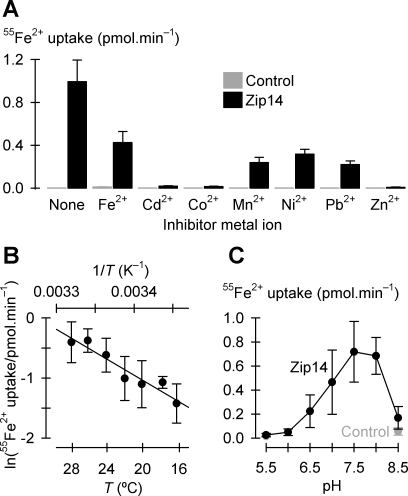Fig. 4.
Properties of Zip14-mediated Fe2+ transport. A: metal-ion inhibition profile of Zip14-mediated 55Fe2+ transport. Uptake of 2 μM 55Fe2+ in the absence (None) or presence of a range of candidate inhibitor metal ions each at 20 μM, in the presence of 1 mM l-ascorbic acid, in control oocytes (gray bars) and oocytes expressing Zip14 (black bars) (n = 10–14). Within Zip14, all metals inhibited 55Fe2+ uptake (P < 0.001). B: temperature (T) dependence of Zip14-mediated uptake of 2 μM 55Fe2+ (n = 9–13). Data were fit by Eq. 2 to obtain activation energy (Ea) = 15.2 ± 2.0 kcal/mol, ln(A) = 25.0 ± 3.5 (adjusted r2 = 0.90, P < 0.001). For clarity, control data are not displayed. C: uptake of 2 μM 55Fe2+ as a function of extracellular pH in oocytes expressing Zip14 (black symbols and line, n = 27–30). Within Zip14, uptakes at each pH differed from one another (unadjusted P < 0.007) except pH 6.5 cf. pH 8.5 (unadjusted P = 0.20), pH 7.5 cf. pH 8.0 (unadjusted P = 0.44), and pH 6.0 cf. pH 5.5 (unadjusted P = 0.54). For this experiment, uptakes in control oocytes (gray symbols and line) were tested only at pH 5.5 and 8.5 (n = 31–32). Zip14 did not differ from control at pH 5.5 (unadjusted P = 0.77) but did at pH 8.5 (unadjusted P = 0.004).

